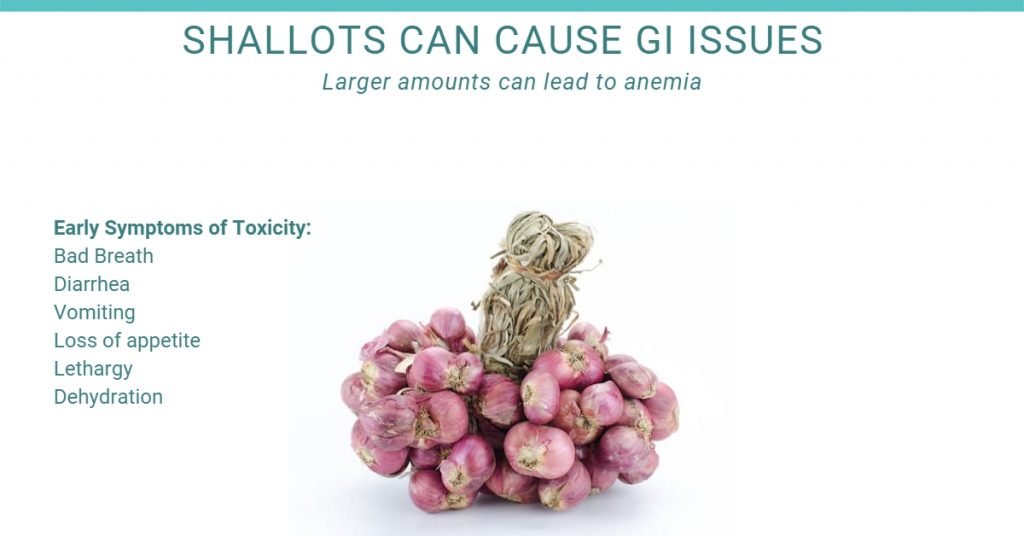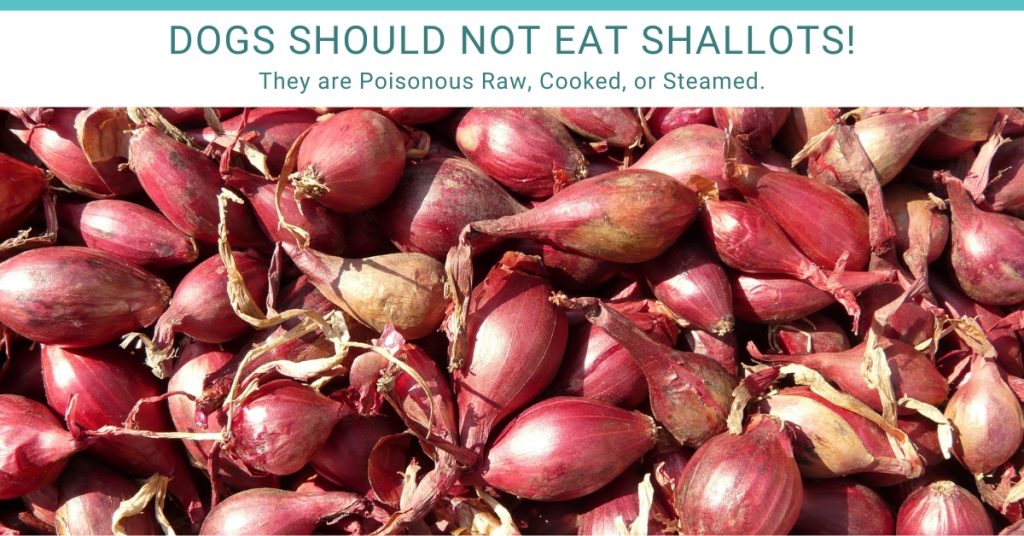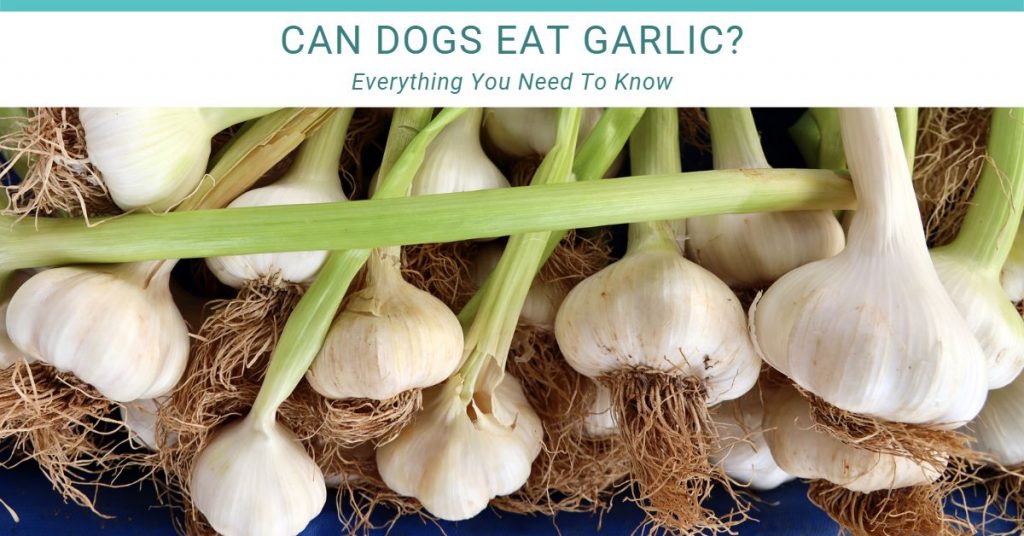Shallots and Dogs: Can Dogs Eat Shallots?
Shallots are found in many households around the world due to their subtly sweet mild flavor. They make an excellent addition to many different meals and also can replace onions in most dishes.
However, what you really want to know is, can dogs eat shallots?
No, dogs can’t eat shallots! The allium genus is the category of plants that shallots, onions, garlic, chives, and leeks all fall into. Since they are all similar in their chemical makeup, most of them are toxic. The exception is garlic, there is a study that shows small amounts can be good for dogs. Eating large amounts of shallots can lead to a serious side effect called anemia. Even smaller quantities can lead to GI distress which isn’t pleasant for you or your dog.
Shallots can have a toxic effect on your dog if too much is consumed. I just want to clear the air and say that if your dog ate some, it does not mean it’s going to be fatal. The size of the dog, the breed, and how much was consumed all factor into what the outcome will be. The typical shallot is about 40 grams. Per a study on onions, dogs can eat about 15-30 grams per KG of body weight. So a 10 KG dog can consume roughly 150 grams of shallot in order to possibly see toxic effects. That means the dog would need roughly to eat 3 full shallots to be on the low side of toxicity.

What Is Shallot Toxicity In Dogs?
Shallot toxicity occurs in dogs when they consume too much. This is usually about the 15 grams per KG of body weight ratio. When they consume more than this, which is not very likely to occur, they can see many different side effects. More on that side effects later.
So what is in the shallot that causes toxicity? There are chemical compounds that give them distinct smell and flavor. When anything in the allium family is cut, there are two main compounds that mix, the enzyme called Allinase and the sulfur compounds. This mixing causes a chemical reaction and generates sulfonic acid as a result.
The sulfonic compounds are toxic to the dog. These same sulfonic compounds are what provides humans with health benefits from eating the alliums. So what is good for the goose is not always good for the gander.
When enough shallot is consumed by the dog, the sulfur compounds will react with the red blood cells. They cause oxidation to the dog’s blood which essentially makes the cell unable to carry oxygen. The dog’s internal systems will then filter out these bad blood cells which reduce the overall red blood cell count. This will also cause the presence of Heinz bodies on the dog’s red blood cells. This condition can be tested with a blood smear test. It is used to identify Heinz body anemia.
The onset of anemia can take anywhere from 3-7 days to show clinical signs with the dog. Anemia can cause many other issues in your pet which is why it is essential to seek medical advice if your dog ate more than the 15g per 1kg of body weight ratio. In short, call your vet if your dog ate shallots. They may want to see the dog depending on the amount that was eaten. There is also about a 2-hour window where the vet can induce vomiting to help clear the toxins out of the dog’s stomach.
Symptoms of Shallot Toxicity In Dogs.
It is not very common for a dog to have toxic effects from the consumption of shallots. Most dogs will not readily eat them due to their taste. However, puppies that chew everything or even older dogs that are active chewers are at a higher risk of exposure. Your dog is also at a higher risk of shallot exposure if you grow your own in a home garden.
The symptoms of shallot toxicity are the same as the symptoms of onion poisoning in dogs. The dog will start out with some kind of GI distress. You most likely will see some or all of the below issues with your dog after consuming shallots.
- Vomiting
- Diarrhea
- Bad breath
- Loss of appetite
- Lethargy
- Dehydration
More Severe Symptoms Of Shallot Toxicity
If the dog ate enough shallots to cause anemia, the following symptoms can present a few days after they were eaten. It can take anywhere from 3 days to a week for the signs of anemia to kick in.
- Fainting
- Gums can turn white and void of the normal pink color
- Rapid breathing
- Rapid heart rate
Contact your veterinarian immediately if your dog shows any of these symptoms. Even if your dog did not eat enough to become anemic, it may require some intervention to combat any dehydration caused by the associated GI issues.
How To Treat Shallot Poisoning In Dogs At Home.
This is a very loaded question. Making a poor judgment call here can lead to the death of your dog. It is always recommended that you call your veterinarian if your dog seems to be in bad shape. However, there are some things that can be done if your dog only has some mild symptoms.
Wait about 24 hours for the GI distress(vomiting and loose stools) to end. Frequently check the dog for dehydration. Push fluids and some recommend homemade chicken broth or bone broth. This is pretty easy to make. It is actually a byproduct of the second step which is a bland diet for the dog.
If the dog does not develop any new symptoms, you can start the dog on a bland diet. To make this, boil some chicken in water. It is best to use deboned thigh meat and some chicken breast. Cool and save the broth that is leftover, skim and discard any of the fat off the top. This fluid can be used to maintain the dog’s hydration.
Once the GI issues stop, slowly feed the dog the boiled chicken(do not feed hot). You can also add a 1/4 cup of boiled rice. Feed smaller meals more often until the dog is able to hold them down. Be ready for accidents, they can happen when the GI tract is under stress from toxins.
After a few days, you can slowly introduce the dog’s normal food while still feeding the boiled chicken. It is best to phase out the boiled chicken while slowly adding more and more of the dog’s normal food. After about 7 days, your dog should be eating 100% of its normal food only.
Can Dogs Eat Shallots – Related Questions
Can dogs eat shallots cooked?
Can dogs survive eating any shallots?
How many shallots are toxic to my dog?
How quickly do dogs get symptoms after eating shallots?

Summary: Can dogs eat shallots?
- Shallots are toxic to dogs in the amount over 15G/KG of body weight
- Symptoms start as little as an hour after consumption
- Anemia does not present until after 3-7 days
- Contact your vet immediately if your dog ate a large number of shallots, there is a two-hour window to induce vomiting.
- For recent posts please go here candogseat.co
Please comment below if your dog has ever eaten shallots! What were the symptoms that the dog had? How long did it take for the symptoms to subside?



